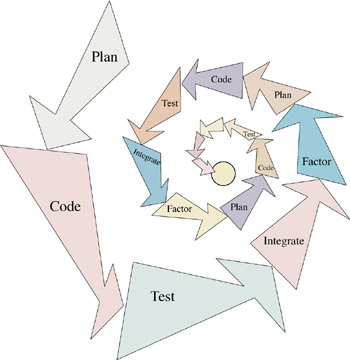The Development Cycle
|
| < Day Day Up > |
|
When you move into the design phase of your project you will start to employ the development cycle. It is good to have a broad, macro-level design idea to get you started, but don’t make the mistake of trying to design everything up front. Design until you can begin coding and test some of your design ideas. The development cycle is summarized in the following table.
| Development Cycle Step | Explanation |
|---|---|
| Plan | Do enough design to get you started with the implementation. Do not attempt to design everything up front. The idea here is to keep your design flexible and open to change. |
| Code | Implement what you have designed. |
| Test | Thoroughly test each section or module of source code. The idea here is to try and break it before it has a chance to break your application. Even in small projects you will find yourself writing little test case programs on the side to test something you have just finished programming. |
| Integrate | Add the tested piece of the application to the rest of the project. |
| Refactor | This step applies more to object-oriented programming than to procedural programming. It means to take a comprehensive look at your overall application architecture and migrate general functionality up into base, or even abstract, classes so the functionality can be utilized by more concrete derived classes. |
The development cycle will be employed in a tight spiral fashion as depicted in figure 3-1. By tight spiral I mean you will begin with the plan step, followed by the code step, followed by the test step, followed by the integrate step, optionally followed by the factor step. Once you have finished a little piece of the project in this fashion, you go back to the Plan step and repeat the process. Each complete plan, code, test, integrate, and factor sequence is referred to as an iteration. As you iterate through the cycle you will begin to notice the time it takes to complete the cycle from the beginning of the plan step to the completion of the integrate step decreases. The development cycle spirals tighter and tighter as development progresses until you converge on the final solution.

Figure 3-1: Tight Spiral Development Cycle Deployment
|
| < Day Day Up > |
|
EAN: 2147483647
Pages: 340